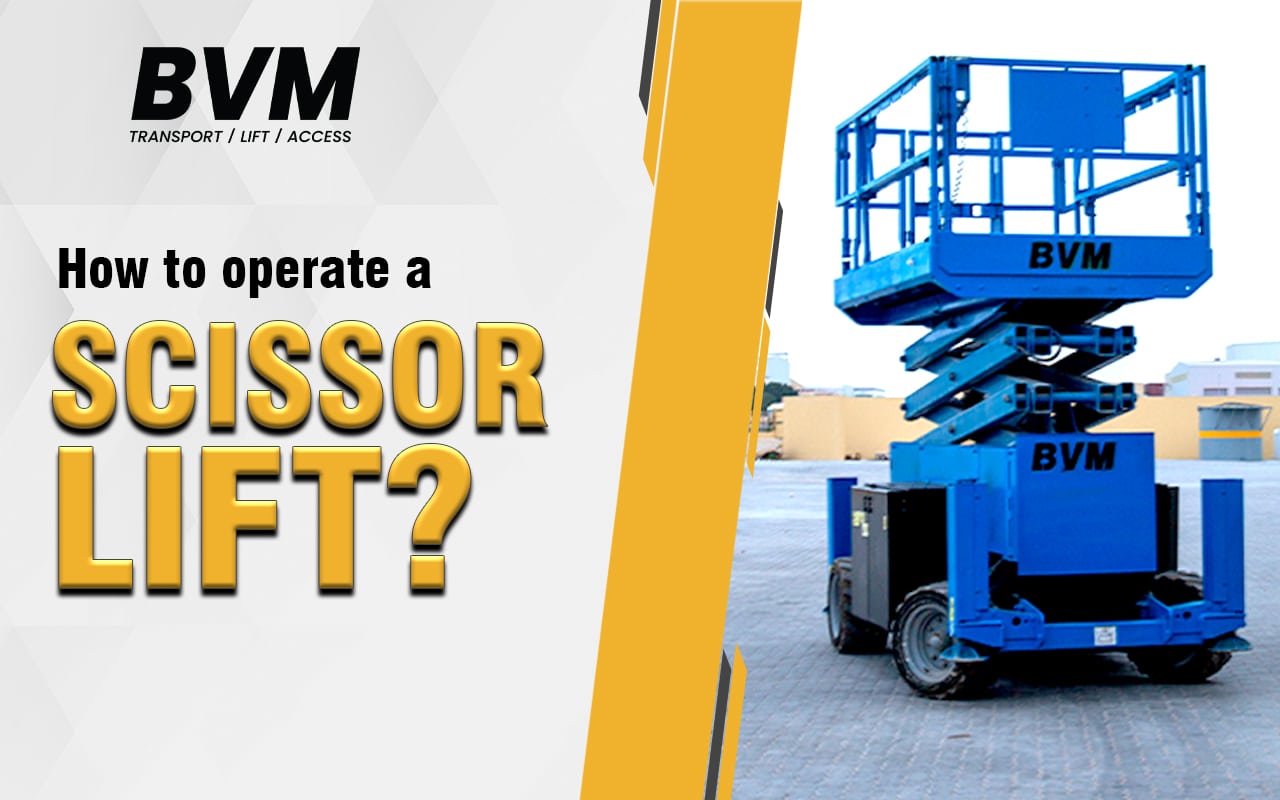
A scissor lift is a versatile and useful piece of equipment for working at heights, but proper operation is essential.
By following comprehensive safety procedures and developing a thorough understanding of scissor lift controls, operators can leverage these platforms efficiently while protecting themselves and others.
Before moving forward, let’s learn more about these lifts.
What Exactly is a Scissor Lift?
A scissor lift consists of a work platform connected to a folding crisscross support structure known as a pantograph. The pantograph utilizes hydraulic cylinders that extend the scissor mechanism upwards to elevate the platform. This allows the equipment to serve as a mobile aerial workstation that can reach working heights between 10 to 50 feet.
Things to Prepare for Safe Operation
1) Inspect for Damage: Before using a scissor lift make sure that you carefully examine the entire lift. Check the platform, tires, guardrails, controls, and safety devices for any signs of malfunction, excessive wear, or damage. Also verifies that emergency features like descent control, safety locks, and alarm systems are functioning properly.
2) Evaluate the Environment: Not all scissor lifts are optimum for every environment. Therefore, evaluate ground conditions to confirm adequate stability, clearance, and load capacity for the scissor lift. Check for overhead obstacles like pipes or electrical lines, and take note of nearby workers and equipment that could be impacted.
3) Select Proper Equipment: Choose a scissor lift that aligns with the height, reach, and capacity required for the planned work. Larger rough terrain lifts may be preferable for outdoor job sites with uneven terrain.
4) Use Personal Protective Equipment (PPE): Wear hard hats, safety glasses, and safety harness per the manufacturer’s recommendations and as warranted by the work environment.
How to Operate a Scissor Lift?
The operation of a scissor lift involves several critical steps and safety measures:
1) Entering the Lift
Use installed steps and grab handles when entering the platform. Close the access gate before operating and lock it properly in place. Attach and secure all safety harnesses provided. Familiarize yourself with the control panel, locating the emergency stop button, master switch or key, and movement controls. Manipulate functions like lift/descent, steering, and outriggers to understand responsiveness. If operating a trailer lift, detach and chock wheels appropriately before use.
2. Raising/Lowering Platform
When ready, utilize controls to carefully ascend in one steady, gradual motion, drive smoothly, and avoid sudden acceleration. Position yourself in the lift’s center without leaning on or grasping guardrails for maximum stability. Cautiously elevate just enough to clear the work zone, watching for overhead obstructions. Avoid unnecessary swaying by accelerating/braking smoothly. When lowering, descend steadily down to the closed base position for optimal stabilization before attempting drive functions.
3. Maneuvering the Lift
Fully lower platform before relocation. Drive only on firm, level surfaces – not slopes, ramps, or uneven terrain. Maintain safe speeds avoiding sudden stops and starts which can make an elevated platform fall. Utilize an assistant as a spotter to warn of potential collisions, especially in tight spaces and blind corners. Deploy outriggers when stationary on irregular ground. Never override safety limits or capacity ratings.
4. Securing the Lift
When finished operating, fully lower the platform and stow accessories like outriggers. Deactivate the master switch/key and engage locking features to prevent unauthorized use. Check for hydraulic leaks, abnormal noises, damaged components, or visible wear regularly. Follow maintenance schedules and safety protocols at all times to ensure safe, reliable scissor lift operation.
Enhanced Safety Tips
To further ensure the safe and effective use of scissor lifts, consider these advanced safety tips and best practices:
1. Comprehensive Training Essential
Operators should undergo extensive instruction on the assigned lift models that cover capacities, hazards, accessories, and safe maneuvering techniques. Plus, to make sure operators are equipped with proper training regular certification renewal per industry standards is compulsory.
2. Diligent Maintenance Critical
Adhere to manufacturer service schedules, inspecting hydraulics, electrical systems, and structural components. Address any identified defects promptly using approved parts/providers to mitigate safety risks.
3. Environmental Conditions Significant
Carefully assess weather and terrain when working outdoors. Lift stability can be impacted by high winds, precipitation, extreme temperatures, uneven ground, and slope gradients.
4. Emergency Protocols Mandatory
Ensure operators can locate and activate emergency stop buttons to instantly halt lift operation if needed. Manual lowering procedures must be clearly understood in case of power failure or control malfunction.
5. Incident Reporting and Investigation
Promptly report all incidents or near-misses to facilitate timely investigation into root causes. This enables the implementation of appropriate corrective and preventative measures, like added training, equipment changes, or updated protocols.
Conclusion
Whether a novice or experienced operator, following secure lift procedures is imperative.
This covers proper inspection, ascent, maneuvering, and securing the equipment post-operation.
Additionally, ensuring your rental equipment itself is engineered for stability by a trusted industry leader can make all the difference for on-site safety.
For your upcoming lift rental needs, choose BVM Transport, one of the renowned transport companies in Dubai. Their lift designs, heavy-duty construction, and intuitive controls provide operators with optimal access, maneuverability, and confidence at height.
So, what are you waiting for? Contact us to buy a scissor lift or boom lift to keep your elevated jobs secure, efficient, and incident-free from start to finish.